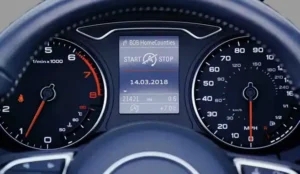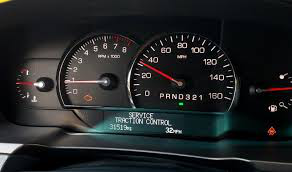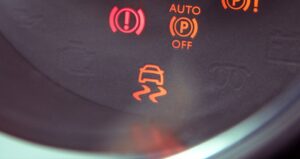
Traction Control vs. Stability Control, What is Traction Control? What is Stability Control? How do ABS, Traction Control, and Stability Control perform together? Which setting is best for stability control?
What is Traction Control?
To allow vehicles to make optimal use of the acceleration traction available on any given surface by measuring wheelspin, this safety feature was engineered. Using the anti-lock-braking system’s hydraulic solenoids to apply braking pressure or using the engine’s electronic throttle, fuel, and spark control to trim power and slow the spinning wheel. Frequently these systems offer the option of being switched off. To do so, this button might be marked Traction Control (TC), Traction Control Light (TCL), with an icon shown. the rear of a car above two S-shaped backward burnout marks. When the vehicle is equipped with stability control and traction, then it will be controlled by the same button that may be labeled Electronic Stability Control (ESC) or Vehicle Stability Control (VSC) or with an icon.
What is Stability Control?
All the hardware required by the traction and anti-lock system presents a modern stability control system. (At every wheel, a brake pedal application sensor and wheel speed sensor, and hydraulic can relieve it, and it adds the pressure at every wheel independently and adds many new sensors. A steering wheel position sensor is responsible for to inform the driver’s intended path and speed, and this is joined to the brake and accelerator pedal sensor, so it is very helpful in this purpose. How much the vehicle is rotating around its vertical axis, yaw is a sensor that measures this. as you experience a skid or spin, and both lateral and longitudinal acceleration detected by a three-axis accelerometer module, as well as whether the vehicle is driving on any angular slop. Consultation of these sensors, the most powerful computer that compares the vehicle’s actual position with the intention of the driver. If two miss-match, then the system applies individual wheel brakes (engine control, if necessary). It brings the path of the vehicle into alignment with the intention of the driver. Remember that in the U.S stability control became mandatory in 2012, so all new passenger vehicles are equipped with the holy trinity of driver-assist systems. Traction, ABS, stability control.
Changing of vehicle’s path due to stability control
If you ever go canoeing, kayaking, whitewater rafting, you have the experience of steering a boat paddling on the back side that you want to steer. Stability control performs the same function. At one side of the car add brake pressure to gently steer in that direction. How much the front or rear brakes are applied depends on the varying results. Note that if the driver has dialed in the desired amount of steering, and if the car does not behave as it should, then minimized the traction, extreme winds and other factors that are causing the path to deviate, there is unlikely to be a desired effect in simply ordering electric steering assist to steer more. A deft stability control system works, without noticing the driver, except for the blinking stability control lamp that it shows the system is working.
How do ABS, Traction control, and Stability Control perform together?
Without ABS, it’s impossible to have traction or stability control. The anti-lock braking system’s hydraulic valve block can regulate the wheel-speed that is required to limit wheelspin for traction control and for vehicle path control by stability control. In some cases, some vehicles permit the driver to disable or dial back the system’s effectiveness. The most prevalent are Traction -control off buttons and Stability off -buttons are less so (and if they present they may be placed in screen menus and they can cause the system to turn completely, such as we see frequently in our Figure Eight Testing).
Which setting is best for stability control?
Different settings required for performance of the vehicles ( such as Chevrolet Corvettes, BM cars, and many Cadillac V-cars) have faced more aggressive situations during driving. In some conditions these offer many settings that owners forums equipped with the answer to the question, probably better. The stability control intervention in each to suit the different terrains if the off-roads oriented vehicles that provide the various terrains modes tailor the level. So the best method of setting up is to match the terrains you are covering. In the other case the best advice is to be given to the John and Jane Q Public to allow those traction and stability control buttons to be left alone on the roads of the public. By pressing and holding a button for many seconds, the performance of mode settings are accessible only from inside the deep infotainment system menu trees. They make the system permissive of neutral slides, and even some situations of oversteer drifts. High performance driver training courses if you have the performance of high driver training courses driving the car on a closed course, if you have re-planning with safety guard rails and so forth (if something goes badly wrong, then prepare for the insurance) including these settings may make your car more fun to drive. If you touch or stab the brakes from the middle of a slide, note that many, but not all, of these systems revert to full safety of the net mode.
When to turn off the stability control?
Have you ever won the title of an SCCA (Sports Car Club of America) or finished the race of a Le Mans? In measuring the MotorTrend Figure Eight performance at our test facility, are you helping Kim Reynolds? If your answer is no to all of these, or it may be never, that is why the manufacturers make it difficult to access the ”off” mode, so anybody does not turn it off accidentally. Turning the stability control completely off on public roads, we never recommend it. ”Off’ setting may be valuable for those drivers who seek to fully explore the limits of their high performance vehicle on a closed road or track, but in exceptional cases.
Causes of Stability Control Light to come on
This is a safety system. Continuously monitored its functionality through diagnostic electronics. When this light comes on, then the system is either switched off, and the lower levels of sensitivity switched or faces any kind of fault. ( System’s effectiveness reduces due to some off-road terrain modes and illuminates the lamp when in those modes). System has a fault, if you have not touched a switch and it comes on. These are sensor malfunctions and sensors mounted in the element that are first to go, such as the wheel speed sensors. These can be damaged by road hazards or become corroded and can be knocked out of alignment. When the traction or Stability Control System is intervening to bring the car back under control, the light will oftentimes flash.


